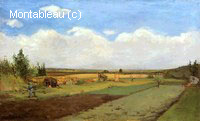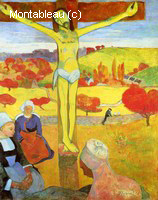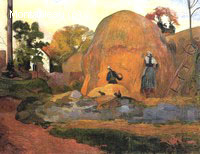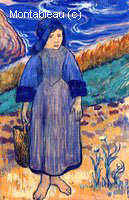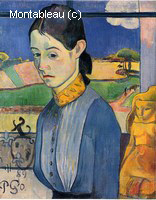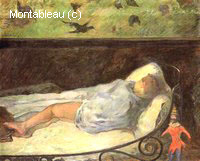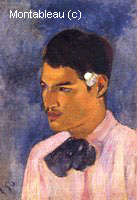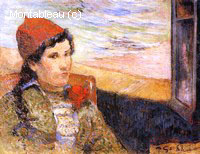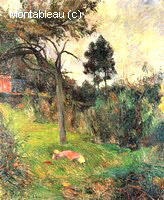
Gauguin Paul
"Notes Synthetiques", by Paul Gauguin From the manuscript, c. 1888 Excerpted from "Theories of Modern Art", by Herschel B. Chipp "Painting is the most beautiful of all arts. In it, all sensations are condensed; contemplating it, everyone can create a story at the will of his imagination and-with a single glance-have his soul invaded by the most profound recollections; no effort of memory, everything is summed up in one instant. -A complete art which sums up all the others and completes them. -Like music, it acts on the soul through the intermediary of the senses: harmonious colors correspond to the harmonies of sounds. But in painting a unity is obtained which is not possible in music, where the accords follow one another, so that the judgment experiences a continuous fatigue if it wants to reunite the end with the beginning. The ear is actually a sense inferior to the eye. The hearing can only grasp a single sound at a time, whereas the sight takes in everything and simultaneously simplifies it at will. "Like literature, the art of painting tells whatever it wishes, with the advantage that the reader immediately knows the prelude, the setting, and the ending. Literature and music require an effort of memory for the appreciation of the whole; the last named is the most incomplete and the least powerful of arts. "You can dream freely when you listen to music as well as when looking at a painting. When you read a book, you are a slave of the author's thought. The author is obliged to address himself to the mind before he can impress the heart, and God knows how little power a reasoned sensation has. Sight alone produced an instantaneous impulse. But then, the men of letters alone are art-critics; they alone defend themselves before the public. Their introductions are always a justification of their work, as if really good work does not defend itself on its own. "These gentlemen flutter about the world like bats which flap their wings in the twilight and whose dark mass appears to you in every direction; animals disquieted by their fate, their too heavy bodies preventing them from rising. Throw them a handkerchief full of sand and they will stupidly make a rush at it. "One must listen to them judging all human works. God has created man after his own image which, obviously, is flattering for man. "This work pleases me and is done exactly the way I should have conceived it." All art criticism is like that: to agree with the public, to seek a work after one's own image. Yes, gentlemen of letters, you are incapable of criticizing a work of art, be it even a book. Because you are already corrupt judges; you have beforehand a ready-made idea-that of the man of letters-and have too high an opinion of your own thoughts to examine those of others. You do not like blue, therefore you condemn all blue paintings. If you are a sensitive and melancholy poet, you want all compositions to be in a minor key. -Such a one likes graciousness and must have everything that way. Another one likes gaiety and does not understand a sonata. "it takes intelligence and knowledge in order to judge a book. To judge painting and music requires special sensations of nature besides intelligence and artistic science; in a word, one has to be a born artist, and few are chosen among all those who are called. Any idea can be formulated, but not so the sensation of the heart. What efforts are not needed to master fear or a moment of enthusiasm! Is not love often instantaneous and nearly always blind? And to say that thought is called spirit, whereas the instincts, the nerves, and the heart are part of matter. What irony! "The vaguest, the most undefinable, the most varied is precisely matter. Thought is a slave of sensations. I have always wondered why one speaks of "noble instincts." . . . "Above man is nature. "Literature is human thought described by words. "Whatever talent you may have in telling me how Othello appears, his heart devoured by jealousy, to kill Desdemona, my soul will never be as much impressed as when I have seen Othello with my own eyes entering the room, his forehead presaging the storm. That is why you need the stage to complement your work. "You may describe a tempest with talent-you will never succeed in conveying to me the sensation of it. "Instrumental music as well as numbers are based on a unit. The entire musical system derives from this principle, and the ear has become used to all these divisions. The unit is established through the means of an instrument, yet you may choose some other basis and the tones, half-tones, and quarter-tones will follow each other. Outside of these you will have dissonance. The eye is used less than the ear to perceive these dissonances, but then divisions [of color] are more numerous, and for further complication there are several units. "On an instrument, you start from one tone. In painting you start from several. Thus, you begin with black and divide up to white-the first unit, the easiest and the most frequently used one, hence the best understood. But take as many units as there are colors in the rainbow, add those made up by composite colors, and you will reach a rather respectable number of units. What an accumulation of numbers, truly a Chinese puzzle! No wonder then that the colorist's science has been so little investigated by the painters and is so little understood by the public. Yet what richness of means to attain an intimate relationship with nature! "They reprove our colors which we put [unmixed] side by side. In this domain we are perforce victorious, since we are powerfully helped by nature which does not proceed otherwise. A green next to a red does not produce a reddish brown, like the mixture [of pigments], but two vibrating tones. If you put chrome yellow next to this red, you have three tones complementing each other and augmenting the intensity of the first tone: the green. Replace the yellow by a blue, you will find three different tones, though still vibrating through one another. If instead of the blue you apply a violet, the result will be a single tone, but a composite one, belonging to the reds. "The combinations are unlimited. The mixture of colors produces a dirty tone. Any color alone is a crudity and does not exist in nature. Colors exist only in an apparent rainbow, but how well rich nature took care to show them to you side by side in an established and unalterable order, as if each color was born out of another! "Yet you have fewer means than nature, and you condemn yourself to renounce all those which it puts at your disposal. Will you ever have as much light as nature, as much heat as the sun? And you speak of exaggeration-but how can you exaggerate since you remain below nature? "Ah! If you mean by exaggerated any badly balanced work, then you are right in that respect. But I must draw your attention to the fact that, although your work may be timid and pale, it will be considered exaggerated if there is a mistake of harmony in it. Is there then a science of harmony ? Yes. "In that respect the feeling of the colorist is exactly the natural harmony. Like singers, painters sometimes are out of tune, their eye has no harmony. Later there will be, through study, an entire method of harmony, unless people neglect it, as is done in the academies and most of the time also in studios. Indeed, the study of painting has been divided into two categories. One learns to draw first and then to paint, which means that one applies color within a pre-established contour, not unlike a statue that is painted after it is finished. I must admit that until now I have understood only one thing about this practice, namely that color is nothing but an accessory. I 'Sir, you must draw properly before painting"-this is said in a pedantic manner; but then, all great stupidities are said that way. "Does one wear shoes instead of gloves? Can you really make me believe that drawing does not derive from color, and vice-versa? To prove this, I commit myself to reduce or enlarge one and the same drawing, according to the color with which I fill it up. Try to draw a head by Rembrandt in his exact proportions and then put on the colors of Rubens-you will see what misshapen product you derive, while at the same time the colors will have become unharmonious. "During the last hundred years large amounts have been spent for the propagation of drawing and the number of painters is increasing, yet no real progress has been made. Who are the painters we admire at the present? All those who reproved the schools, all those who drew their science from the personal observation of nature. Not one ..."
See more
